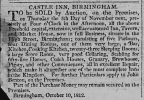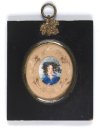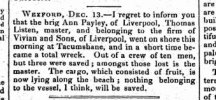-
Welcome to this forum . We are a worldwide group with a common interest in Birmingham and its history. While here, please follow a few simple rules. We ask that you respect other members, thank those who have helped you and please keep your contributions on-topic with the thread.
We do hope you enjoy your visit. BHF Admin Team -
HI folks the server that hosts the site completely died including the Hdd's and backups.
Luckily i create an offsite backup once a week! this has now been restored so we have lost a few days posts.
im still fixing things at the moment so bear with me and im still working on all images 90% are fine the others im working on now
we are now using a backup solution
You are using an out of date browser. It may not display this or other websites correctly.
You should upgrade or use an alternative browser.
You should upgrade or use an alternative browser.
Castle Street
- Thread starter Vivienne14
- Start date
JudiM
master brummie
I was wondering that, but I'm not sure. The Pavilions went up in the later 80's, after the Co-op was demolished. I don't remember being able to cut through all the way down to Moor Street before then, which I'm sure I would have done as I came into Town usually on the train to & from Moor Street station, certainly most Saturday's from 82 onwards & as a weekday commute from 85.Presumably when the shopping centre building that was later replaced by Primark was built, as M & S had the top floor of it
I remember it being an alley with the entrance to the hairdressers & an opticians (I think) but I don't think it was open at both ends.
i would guess middle 50s to 60s mike
lyn
A Sparks
master brummie
I think that's Hilton's ladies clothes shop on the right isn't it? It's been gone a long time - 60's or 70's maybe?
JudiM
master brummie
I think there could have been an answer in this thread, but the photos have gone -
 birminghamhistory.co.uk
birminghamhistory.co.uk
Van Allen clothes shops
I am reading a book.a novel. and it mentions the clothes shop Van Allen. This bought back memories of buying a dress from there BUT where was the shops situated? Along with C&A Modes it has long gone.........but do you girls remember it?
 birminghamhistory.co.uk
birminghamhistory.co.uk
i will have a look for photos of castle st in my files and post if i have any...just reading again through this thread and over 200 years later the murder of young mary ashford still fascinates..i wonder just how many of marys family do not know about her and if her grave is ever attendedI think there could have been an answer in this thread, but the photos have gone -
Van Allen clothes shops
I am reading a book.a novel. and it mentions the clothes shop Van Allen. This bought back memories of buying a dress from there BUT where was the shops situated? Along with C&A Modes it has long gone.........but do you girls remember it?birminghamhistory.co.uk
lyn
Last edited:
Lady Penelope
master brummie
I think you're probably right about Mary's family but her grave is at Holy Trinity, Sutton Coldfield and I'll check this afternoon to see what's happened to it as there have been major renovations there lately. I need to look for another grave too so it may mean a trip up the hill.i will have a look for photos of castle st in my files and post if i have any...just reading again through this thread and over 200 years later the murder of young mary ashford still fascinates..i wonder just how many of marys family do not know about her and if her grave is ever attended
lyn
Lady Penelope
master brummie
May Ashford's Grave - Apparently the grave is in a very poor condition and the brickwork is now exposed so not long before that goes the same way. Nobody is looking after it as it's the family's responsibility not the church's. I have to go and search for another grave so I'll try to locate it on my visit and take a photo.
thats great pen..would like to see a photo is possible...oh tread carefully up that hillMay Ashford's Grave - Apparently the grave is in a very poor condition and the brickwork is now exposed so not long before that goes the same way. Nobody is looking after it as it's the family's responsibility not the church's. I have to go and search for another grave so I'll try to locate it on my visit and take a photo.
lyn
Ian Broinowski
master brummie
Hi Everyone,
My name is Ian Broinowski and I am writing from Tasmania. Thankyou all for the information you have provided about the life and times of Mary. I am interested in another Mary. She was Mary Morton Chapman who lived at the Castle Inn from when she was 6 and left for boarding school at about the same time as Mary's death. They would certainly have known each other and perhaps she even bought eggs from Mary.
Mary Chapman was daughter to William licensee of the Castle Inn and married Joseph Allport. They emigrated to Van Diemen's Land in 1831. She left an amazing legacy of art works which can be seen from the Tas State Library https://librariestas.ent.sirsidynix...ailability Online Online&rw=96&st=PA&isd=true
I am writing to see if anyone has any more information about the Inn or the Chapman family around the time of Mary Ashgrove.
Look forward to hearing from you. my email is [email protected]
Ian
My name is Ian Broinowski and I am writing from Tasmania. Thankyou all for the information you have provided about the life and times of Mary. I am interested in another Mary. She was Mary Morton Chapman who lived at the Castle Inn from when she was 6 and left for boarding school at about the same time as Mary's death. They would certainly have known each other and perhaps she even bought eggs from Mary.
Mary Chapman was daughter to William licensee of the Castle Inn and married Joseph Allport. They emigrated to Van Diemen's Land in 1831. She left an amazing legacy of art works which can be seen from the Tas State Library https://librariestas.ent.sirsidynix...ailability Online Online&rw=96&st=PA&isd=true
I am writing to see if anyone has any more information about the Inn or the Chapman family around the time of Mary Ashgrove.
Look forward to hearing from you. my email is [email protected]
Ian
Attachments
Ian Broinowski
master brummie
Thankyou MWS I really appreciate you feedback. Yes thats right she went to boarding school there and then married her teachers son. Joseph.
MWS
from Bham
I assume you know that the name Morton was her paternal grandmothers (Ann/Hannah Morton).
A little more on William's son - Humphrey Evett Chapman - he appears to have been the Captain of the brig Ann Payley that was lost at sea. There's a mention of the ship here...
 discovery.nationalarchives.gov.uk
discovery.nationalarchives.gov.uk
There appear to be a number of mentions of Mary's maternal grandfather - Humphrey Evett - proprietor of a coaching company. In one (1817) it mentions an auction at his house 'known by the "Sign of the Castle".
A little more on William's son - Humphrey Evett Chapman - he appears to have been the Captain of the brig Ann Payley that was lost at sea. There's a mention of the ship here...
Deposits and Withdrawals Book | The National Archives
The official archive of the UK government. Our vision is to lead and transform information management, guarantee the survival of today's information for tomorrow and bring history to life for everyone.
There appear to be a number of mentions of Mary's maternal grandfather - Humphrey Evett - proprietor of a coaching company. In one (1817) it mentions an auction at his house 'known by the "Sign of the Castle".
Ian Broinowski
master brummie
Fantastic! This will add more to her story and allow me to learn more about her and understand her. Thankyou so muchI assume you know that the name Morton was her paternal grandmothers (Ann/Hannah Morton).
A little more on William's son - Humphrey Evett Chapman - he appears to have been the Captain of the brig Ann Payley that was lost at sea. There's a mention of the ship here...
Deposits and Withdrawals Book | The National Archives
The official archive of the UK government. Our vision is to lead and transform information management, guarantee the survival of today's information for tomorrow and bring history to life for everyone.discovery.nationalarchives.gov.uk
There appear to be a number of mentions of Mary's maternal grandfather - Humphrey Evett - proprietor of a coaching company. In one (1817) it mentions an auction at his house 'known by the "Sign of the Castle".
Ian
Ian Broinowski
master brummie
Hi Mws,
Sorry to keep troubling you. The puzzle is this. The Ann Payley sank in December 1848 as you can see the Master of the vessel was Thomas Listen.
The Ann Paley 10/01/1839 Lost off Cleveleys on voyage to Lisbon which is the Brig referred to in the book you referenced.
I can't find mention of Humphrey Evett Chapman anywhere. Would you mind directing me to the reference you found referring to him as Captain and lost sea.
Thankyou once again for your help
Ian
Sorry to keep troubling you. The puzzle is this. The Ann Payley sank in December 1848 as you can see the Master of the vessel was Thomas Listen.
The Ann Paley 10/01/1839 Lost off Cleveleys on voyage to Lisbon which is the Brig referred to in the book you referenced.
I can't find mention of Humphrey Evett Chapman anywhere. Would you mind directing me to the reference you found referring to him as Captain and lost sea.
Thankyou once again for your help
Ian
Attachments
MWS
from Bham
Can only assume that there was more than one. Sorry, I think I jumped to the conclusion that he went down with his ship, however...
This is from the Aris's Bham Gazette, 31 Jul 1843. Not sure if you can view it so...
"On 20th inst, at sea in his 30th year, Captain Humphrey Evett Chapman, of the brig Ann Paley, Liverpool, third son of the late Mr. William Chapman, of the Castle-Hotel, High-Street, Birmingham. The Ann Payley was on her homeward voyage from Oporto; about seven p.m. Captain Chapman went aloft to look for the Tuscar Light, on the Irish coast, at the entrance to St. George's Channel. In descending the rigging his foot slipped, and he fell backwards overboard, the wind blowing hard at the time, with heavy sea, and the brig making seven knots per hour against tide. A boat was instantly lowered, and every effort made to save him, in vain...he was swept a moment, and for ever, from the unfortunate wife, who witnessed catas..."
His death was also reported in the Coventry Standard and the Leamington Spa Courier but they appear to be just a sentence or so.
Ann Payley doesn't seem to be a particularly lucky name.
This is from the Aris's Bham Gazette, 31 Jul 1843. Not sure if you can view it so...
"On 20th inst, at sea in his 30th year, Captain Humphrey Evett Chapman, of the brig Ann Paley, Liverpool, third son of the late Mr. William Chapman, of the Castle-Hotel, High-Street, Birmingham. The Ann Payley was on her homeward voyage from Oporto; about seven p.m. Captain Chapman went aloft to look for the Tuscar Light, on the Irish coast, at the entrance to St. George's Channel. In descending the rigging his foot slipped, and he fell backwards overboard, the wind blowing hard at the time, with heavy sea, and the brig making seven knots per hour against tide. A boat was instantly lowered, and every effort made to save him, in vain...he was swept a moment, and for ever, from the unfortunate wife, who witnessed catas..."
His death was also reported in the Coventry Standard and the Leamington Spa Courier but they appear to be just a sentence or so.
Ann Payley doesn't seem to be a particularly lucky name.
Ian Broinowski
master brummie
Always been fascinated by this thoroughfare....especially the Pubs and Hotels......and also the Aquarium highlighted in mikejee's map from way back....so here's some more pics to add to the collection, and I love Joe Mckenna's take on it's history, and notably again...for it's role in the history of Birmingham's Theatres! And I include two old maps showing the hostelries quite nicely....
He wrote thus: Two doors further on, though several centuries earlier, was the Reindeer, at what was to become 41 High Street. A mid to late seventeenth-century inn, its licensee in 1663 was John Moorland. In 1691 it became a coaching inn. There is an advertisement to this effect in the London Gazette for 7-11 May: There is a stage-coach goes from the Rain-Deer Inn, in Birmingham, every Monday Morning, 6 o'clock, going through Warwick and Banbury, and comes to the Bell Inn, in West-Smithfield, every Wednesday, and so returns every Thursday, to the Rain-Deer Inn, in Birmingham, every Saturday at 18s. each Passenger. Performed by Nich. Rothwell, of Warwick.
Two years later, in 1693, the building was refaced in brick by builder Richard Pinley. In the early eighteenth century the house was renamed the Castle Inn. Dr Samuel Johnson stayed here in the autumn of 1734. In the stable belonging to the inn was held the first theatrical performance in the town under a permanent cover, before a dedicated theatre was erected in Moor Street. Wiki states: A building "something like a stable" in Castle Yard between High Street and Moor Street was used for dramatic performances from 1730. The standard of production in this new venue was reflected in the remarks of William Hutton, writing later in the century: "here the comedian strutted in painted rags, ornamented with tinsel. The audience raised a noisy laugh, half real and half forced, at three-pence a head”. Not all of the performances of this era were of such low quality, however: later playbills suggest that George Hallam had visited Birmingham with a company of actors from London, and that a repertoire of good quality was being presented in the town, by 1730 at the latest.
John Camden was landlord here between 1767 and 1770. On 22 May 1769 the first meeting of the Commissioners of the Birmingham Lamp Act took place at the Castle Inn, where apparently they continued to meet for some time thereafter.
Samuel Lloyd succeeded Camden. A Mr Piper ran this coaching inn after Lloyd. His widow continued until her retirement in 1785. John Ibberson, whose father ran the George & Blue Boar in Holborn, London, bought the house. During his time the Castle acted as the meeting place of the magistrates during the Scarcity Riots of 1800.
Ibberson was succeeded by another Londoner, William Waddell, who later took over the rival coaching inn, the Hen & Chickens in New Street. When put up for sale in 1812, an advertisement in the Birmingham Gazette (12 October) revealed that the Castle had four dining rooms and twenty-three bedrooms.
William Chapman took over the license, he was followed by John and Thomas Law, and finally, William Felton. The Castle was closed in 1854. Edward Gem, an export merchant, purchased one part, Joseph Barrow the other. Barrow took over the Castle's license, put in new windows, and opened a wine and spirits merchants called the Castle Vaults. This closed down in May 1922.

Hi Denis,
With the help of the Tasmanian Library I have just managed to locate the full advert for the castle inn. I certainly sounds impressive.
I wonder if you could send me the source this "
When put up for sale in 1812, an advertisement in the Birmingham Gazette (12 October) revealed that the Castle had four dining rooms and twenty-three bedrooms.
William Chapman took over the license, he was followed by John and Thomas Law, and finally, William Felton. The Castle was closed in 1854. Edward Gem, an export merchant, purchased one part, Joseph Barrow the other. Barrow took over the Castle's license, put in new windows, and opened a wine and spirits merchants called the Castle Vaults. This closed down" please. My main focus is on William Chapman.
Thankyou
Ian



